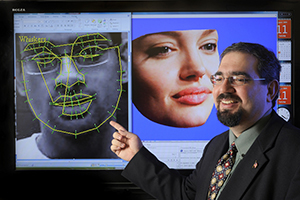Carnegie Mellon’s CyLab Biometrics Center Named Edison Award Finalist
By Daniel Tkacik / 412-268-1187 / dtkacik@andrew.cmu.edu
Thomas Edison would be proud of the achievements of Carnegie Mellon University's CyLab Biometrics Center.
The center, housed in the College of Engineering’s cybersecurity laboratory known as CyLab, has been named a finalist in this year’s Edison Awards in the category of Applied Technology. Since 2008, the Edison Awards have recognized products, institutions and business leaders showing excellence in innovation, with Elon Musk, CEO of Tesla/SpaceX, and Yang Yuanqing, CEO of Lenovo, among those recognized.
“I'm very proud to see the innovative technology my students and I have developed recognized by the Edison Awards,” said Marios Savvides, research professor of electrical and computer engineering and founder and director of the Biometrics Center. “Receiving this award and seeing our technology being used by law enforcement and making an impact is very gratifying.”
 Savvides’ biometrics lab is developing tools that use “bio-metrics,” such as the iris of an eye or the shape of one’s face, to identify people. Much like how law enforcement agencies can identify a person by their unique fingerprint, Savvides’ high-powered long-range iris cameras can identify a person by their unique iris from up to 40 feet away and within a few seconds.
Savvides’ biometrics lab is developing tools that use “bio-metrics,” such as the iris of an eye or the shape of one’s face, to identify people. Much like how law enforcement agencies can identify a person by their unique fingerprint, Savvides’ high-powered long-range iris cameras can identify a person by their unique iris from up to 40 feet away and within a few seconds.
“We’re pushing the limits of current biometric identification technology,” Savvides said.
The lab also is working to develop software tools that can reconstruct partially occluded faces in photographs, such as when a subject’s face is not directly facing the camera or when only part of a subject’s face is captured. Having a picture of one’s entire face makes it much easier to identify. Savvides’ technology can do this even with a blurry, low-resolution image.
“Resolution is one of the biggest challenges, because in many of the cases, you’ve got someone who is far away, you’ve got a noisy image, and the image is just too small and out of focus and blurry,” he said.
Much of Savvides’ technology falls within the field of machine learning — a discipline that explores the development of algorithms created by computers that learn from data. For example, Savvides’ facial reconstruction technology is a result of computers studying millions and millions of face images, learning trends and patterns in how faces look, and using that to predict what a face should look like.
“The computer is doing something the human brain cannot do,” Savvides said. “I just find it extremely fascinating how machine learning and pattern recognition can create this artificial intelligence system that can make correct inferences from such small amounts of facial data.”
Savvides will attend the Edison Awards Ceremony on April 23 in New York City, where his lab will receive Gold, Silver or Bronze recognition.
CMU's Biometrics Center has been named a finalist in recognition of Mario Savvides (pictured above), who has developed tools that use “bio-metrics,” such as the iris of an eye or the shape of one’s face, to identify people from up to 40 feet away and within a few seconds.